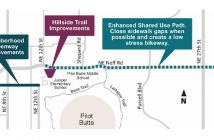(Photo | Courtesy of Bend Chamber)
What do babies and business have in common? Parents — both need ‘em. As new businesses locate or grow in Central Oregon, jobs and opportunities for careers increase. But our growth has not kept pace with the workforce needs of Central Oregon employers. There are many reasons why our region and state are experiencing a workforce shortage, but there is one reason that’s right in front of us, pushing a stroller. There are thousands of people out there who want to work, but can’t find affordable — or any — childcare.
Lack of childcare impacts the workforce in several ways. It is an equity issue for women, who take on much (but certainly not all) of the stay-home parenting, and for those who are economically constrained and want to seek more financial opportunity and career growth while raising their families.
Enter the child care desert dilemma. More and more employees are faced with the lack of available openings for their children — especially for infants. New parents are often placed on wait lists of more than a year before there is an opening for their child. There just aren’t enough quality child care providers in our region. In a recent survey of Bend Chamber of Commerce members, 97 percent of employees have had difficulty finding childcare.
Affordability of child care is also a big part of the problem. Our survey showed that 42 percent of employees say at least a quarter of their income goes to childcare. More than 20 percent of employees spend at least half their paychecks to find safe, quality care for their children while they work.
This is also devastating to businesses and employers. More than 76 percent of employers stated that child care is an important issue to their company. It impacts the ability to attract and retain talent, employee attendance, productivity, retention and salaries. The lack of childcare hurts smaller businesses the worst. Almost 80 percent of the companies surveyed have between 0-50 employees. Our region’s economy depends on a growing workforce. We must find ways to increase available quality childcare while addressing affordability.
So why not just build more childcare facilities? The financial and regulatory barriers for new providers are vast, and those who are attracted to and qualified for this field of work most often do not have the capital to get started. Providers seeking to open or expand facilities are faced with a highly competitive commercial market where property owners will lease to a low-risk/high-profit commercial enterprise rather than a higher-risk/lower-profit childcare center. If providers want to build their own facility, property prices are out of reach. The regulatory requirements and tenant improvements, though important, set huge financial barriers to starting new quality childcare businesses. And finally, providers are faced with limited resources to pay their childcare employees, resulting in low-wage jobs and high turnover.
For more than a year a cross-industry workgroup that has taken on the task of finding solutions. We have approached commercial brokers, property owners, our local higher education institutions, investors and local governments to help find viable solutions to increasing the amount of quality childcare in Bend and our region.
Some of the results of this group’s effort include a two-year reduction on Transportation System Development Charges for childcare centers by the City of Bend to help reduce start-up costs. Additionally, a coalition of local bankers and the Central Oregon Small Business Development Center are developing a business training pipeline for prospective new childcare businesses. We’ve explored Federal Opportunity Zones that are areas where there are advantages to investing capital gains in community assets like childcare facilities. We’re working closely with the Governor’s Regional Solutions team and we’ve also engaged the business community to raise awareness and identify employers who may want to help offset risk for new providers by committing to reserving childcare slots in centers as are aware of the issue and want to help.
Our region is so focused on finding solutions to the problem that we are trying to fund a childcare accelerator to take on this work. This person or company will work all sides of the issue, finding highly-qualified providers, potential banking partners, identifying potential buildings and land, and develop an employer pool of businesses who will commit to help. We have raised $40,000 locally toward this position but need another $60,000 to begin the pilot year.
Raising awareness of the lack of childcare in our region and state as an economic issue may help rally some support for real solutions. Those solutions are more complicated than a first-glance look. The bottom line is if people want to work, we should not stonewall that opportunity by lack of childcare. Our employers desperate for labor and talent, and our families need affordable and available child care to bring them into the workforce.





